| |
Future
Noir: The Second Cut

Article
and Interview by Bryan Ebenhoch
Images
Courtesy of Paul M. Sammon
In celebration of Blade Runner’s 25th Anniversary, it gives us great
pleasure here at BladeZone to once again welcome Mr. Paul M. Sammon, who
will discuss his most recent contributions to the scholarship of Blade
Runner.
Mr. Sammon’s career in the film industry began in the 1970’s
as a publicist. He then went on to perform many other roles in the film
making arena – Studio Executive, Producer, Director, Still Photographer,
Special Effects Coordinator, Actor - while also writing many filmmaking
articles that have graced the pages of American Cinematographer, The Los
Angeles Times, Cinefex, and many other magazines. In addition, Mr. Sammon
has written over a dozen books, and he has either worked with or extensively
covered the works of Sir Ridley Scott, Paul Verhoeven, James Cameron,
John Milius, Steven Spielberg, David Cronenberg, John Landis and David
Lynch.
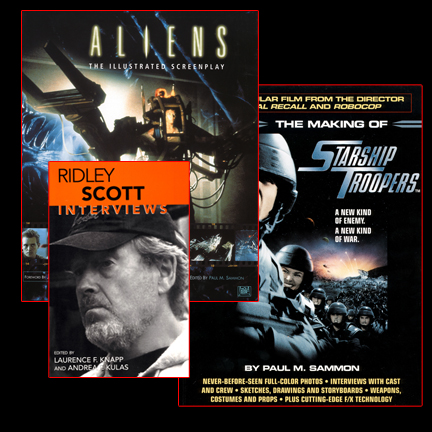
Three recent books authored/contributed to by Paul M. Sammon
During the year 2007 Mr. Sammon was busy composing the Second Edition
of his well-known “Blade Runner Bible,” Future Noir: The Making
of Blade Runner. This second edition hardcover appeared on December 13
2007 from Orion Books in the United Kingdom. It can be ordered from amazon.co.uk
HERE
During 2007,
Mr. Sammon also published three new Blade Runner articles for England’s
Empire Magazine, and wrote a 7000-word essay about Philip K. Dick for
the late 2007 reissue of Dick’s novel “Do Androids Dream of
Electric Sheep?” (this appeared in paperback from Del Rey Books).
Paul also contributed to the Blade Runner: The Final Cut DVD documentaries,
released by Warner Home Video on December 18th, and wrote a number of
“History” articles detailing BR’s evolution for Warner
Home Video’s official Blade Runner website www.bladerunnerthemovie.com

Sammon’s 2007 Empire Magazine Article on Harrison
Ford
We took some time to ask Mr. Sammon about his thoughts on the recent release
of Blade Runner: The Final Cut, and his 25-year long history of supporting
the film.

Paul M. Sammon
in a screenshot from the BR documentary DANGEROUS DAYS
Mr. Sammon, thank you for taking the time to offer your words
to the Blade Runner fan community. We congratulate you on your all your
work and are excited to hear you have a new revised edition of Future
Noir. What will fans expect to see in this new edition?
Approximately
70,000 words of new material. This covers the BR story from 1996, when
the first edition of Future Noir was published, up until 2007, the year
the Final Cut appeared. The Second Edition also includes a 10,000-word
interview with Harrison Ford. It’s the longest interview he’s
ever done on Blade Runner. Harrison was very gracious during our talks;
basically, he told me that because enough time had passed, Ford’s
now made his peace with the film. And with Sir Ridley.
Ford and I spoke twice about BR. We did the longer of the two interviews,
which took about an hour and half, at Harrison’s office near the
Santa Monica airport. That’s where he has a hanger housing his fixed-wing
aircraft and his helicopter. Ford’s a licensed pilot.

Sammon and Ford February 2007
How long did you take writing this new second edition?
Well,
I’ve never stopped collecting information on BR, but I more or less
officially contracted for the new Future Noir during December 2006. Then
I spent months reconnecting with the cast & crew, doing new interviews,
and warehousing a ton of fresh research. I turned in the final manuscript
in early October of 2007. So I spent about 10 months on this version of
the book. Although, really, you could say that I’m always writing
about BR, one way or another (laughs).
Yes,
we’d heard that you’d conducted new interviews with the cast
and crew.
Yeah, I did about 25-30 of those. People I spoke with this time included
Harrison, Michael Deeley, Ivor Powell, Mark Stetson, Hampton Fancher,
David Peoples, and Joanna Cassidy. Charles de Lauzirika, the Restoration
Producer for the Final Cut, was also tremendously helpful; I literally
could not have composed this version of the book without Charlie. And
then I had a terrific and very long chat with Sean Young about Blade Runner.
But that happened far too late in the game to include in this version
of Future Noir. Maybe it’ll appear in the Third Edition! (laughs)

Sammon's Empire Magazine Interview with Producer Charles de Lauzirika
Who can we expect to be included and what additional subjects
have you covered?
First,
there’s a new 50,000-word chapter entitled “The Final Cut.”
That section covers the entire process of creating The Final Cut, including
moments like the “Greenscreen shoot” with Joanna Cassidy and
Ben Ford. This chapter also includes a heavily detailed report on all
the new Blade Runner and Philip K. Dick happenings since 1996. Then there
is the Second Edition’s standalone Harrison Ford interview, which
is done as an appendix, “Appendix J.” There are two other
new appendices as well. One, the Second Edition Data File, is a grab-bag
of anecdotes and BR-related factoids. Here’s where you’ll
find info on the Westwood BR videogame, the new bootleg soundtracks, and
the BR DVD collector sets. The last new appendix in the Second Edition
addresses and corrects some of the typos and misinformation that sneaked
into the first edition. That one’s called “Errata: First Edition
Corrections.”
Were you able to completely revise the first edition?
Unfortunately, no. Only in the sense of the additions
and corrections I've already spoken about. That’s why I was annoyed
to see the word “revised” appear on the cover of the Second
Edition. Because it isn’t – there wasn’t the time or
opportunity to do a complete revision, despite the fact that I very much
wanted to. Anyway, the new material in the Second Edition begins on page
375, with a 105-page chapter called "The Final Cut." That covers
the newest version of the film, the rise in interest in the works of Philip
K. Dick, the BR DVDs produced by Charlie de Lauzirika, the 2004 restoration
of the original Flying Spinner, the PKD Android Project, and a slew of
other topics. The new appendices start on page 548 with Appendix J, the
Harrison Ford interview. Then the Second Edition Data File and the Errata
appendix follow that. These new appendices total about 50 additional pages.
So there are about 150 pages of new material, in toto, in "Future
Noir II".
Are you happy with the way the Second Edition came out?
Well...(laughs). I'm rarely satisfied with the final
state of my books or films, much less made happy by them. Usually, I just
see their blemishes. On the other hand, the Second Edition of Future Noir
was composed under circumstances quite different from the first. The main
difference was that, this time, the Final Cut and BR DVD sets were still
being created while I was writing about them. That situation erected its
own unique set of obstacles - Ridley didn't sign off on the Final Cut
until early August 2007, for example, yet FN's Second Edition was published
just a few months later, in early December. Plus, 2007 was the year of
BR's 25th anniversary, and Warner Home Video mounted a very impressive
slate of promotional efforts all year long to publicize the BR DVDs and
Final Cut. But those efforts lasted virtually up until December 9, the
date when the BR DVD/Bradbury Building party took place. Which is why
that event isn’t in the Second Edition.
What
all this meant was that I was literally writing updates and corrections
up through mid-November of 2007, the month I turned in the Second Edition’s
last few additions. So this version of the book didn’t appear under
the best possible circumstances; for example, I wish that I could have
published the Second Edition about a year later, maybe in late 2008. With
that extra time, I could have compiled more BR data and gained a deeper
perspective on The Final Cut and the BR DVDs. Still, even though the Second
Edition process was a bit daunting, my UK publisher, Gollancz/Orion Books,
couldn't have been more supportive. Gollancz did a great job with the
Second Edition.
What don't you like about the Second Edition?
I'd rather start with something that I do like. There
is now a hardcover version of Future Noir that preserves the first edition
and includes a new 150-page update on BR, which I think is very cool.
As for what I don't like, well, one bother was the matter of timing, as
I’ve already mentioned. There I ran up against a relatively new
wrinkle in contemporary publishing – the tie-in. By that I mean
that books like Future Noir are often slaved to the release date of another
product. The Second Edition FN was no different in that respect, since
it was always positioned to be published at the same time that the BR
DVDs were released. In fact, if there hadn’t been all those BR DVDs
and The Final Cut, there probably wouldn’t have been a Second Edition.
That makes perfect sense, by the way, from a publisher's point of view.
Publishers like to release one thing at the same time that they can capitalize
on the release of another thing, in order to maximize the return on their
investment.
I’m
surprised that there wasn’t enough faith in Future Noir to publish
another edition before this one.
Are
you kidding? Publishing is a business, like the film industry, and the
tyranny of the bottom-line has both fields in its grip. So unless you’re
someone like Stephen King or Steven Spielberg, you gotta line up and beg
for your supper, along with everyone else. Plus, it's gotten harder and
harder to publish off-center books like Future Noir. I know, since I've
been actively trying to get someone interested in a Second Edition since
2002. But there was never any interest in such a thing. Not until 2007,
when The Final Cut and the BR DVDs and Gollancz came along. So when the
opportunity finally presented itself, even given the restrictions that
I’ve mentioned, I jumped at it. Believe me!
Was
there anything else you don’t like about the Second Edition?
My
main difficulties involve its many typos and flawed photo reproductions.
Somewhere between submitting the final draft to the publisher and seeing
the end result after it left the printer, a number of corrections I'd
originally included weren't put into the book. For example, in the
manuscript that I turned in, I'd mentioned that one of Blade Runner's
original illustrators, Mentor Huebner, had passed away since FN's first
edition came out. That same sentence went on to add that Sherman Labby,
BR's other chief illustrator, had also died. But now the book only mentions
Huebner! Plus, Charlie is referred to early on in the Final Cut chapter
as "Charles de Lauzirika", which of course is his correct name.
But then he's named "Charles Lauzirika" through the rest of
that section. Finding errors like that, particularly after you'd previously
corrected them, can be annoying.
I
also wish that the photos in the Second Edition had been better reproduced.
And I'd wanted to include at least a half-dozen new stills in the Second
Edition, things like the Flying Spinner being restored or a behind-the-scenes
shot of Joanna Cassidy being filmed during the Greenscreen shoot. But
I was told about midway through writing the new material that those stills
weren't going to happen. My publisher did say they'd try to get them into
the first softcover version of the Second Edition.
So
generally speaking were you happy working with Gollancz?
Absolutely, despite the nits I’ve just picked.
Orion and my editor, Simon Spanton, were terrific - professional, reasonable,
patient. I really appreciated that last quality, by the way. Particularly
since I was originally commissioned to write only about 10,000 new words
for the Second Edition, and I ultimately turned in 70,000! (laughs)
Will the Second Edition also be published in America?
Not at the moment. Right now the Second Edition is
planned to only be published in two countries. One is England - you can
easily buy it online from amazon.co.uk. HarperCollins, my American publisher,
decided not to do a Second Edition here in the States.
Why?
You'd have to ask HarperCollins. I'm assuming that
someone there did a cost/benefit analysis and came up short. However,
you never know. Perhaps there'll be a change of heart down the line.
Will the new book be in soft cover and Hardcover versions?
Orion's Second Edition Future Noir will be first published in hardcover.
A trade paperback may appear later, perhaps in 2008. But that’s
undecided at the moment.
You mentioned that the new Future Noir would appear in two countries.
So does that mean that there will be other, foreign-language versions
of the Second Edition, as there were with the previous edition?
Yes.
Right now the Second Edition will be published in Japan, as well as in
England. Japanese film buffs have always been fascinated with Blade Runner.
Like me!
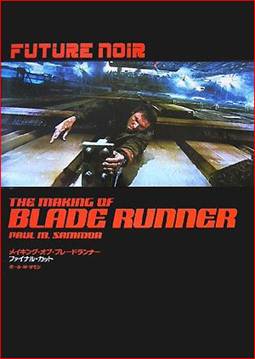
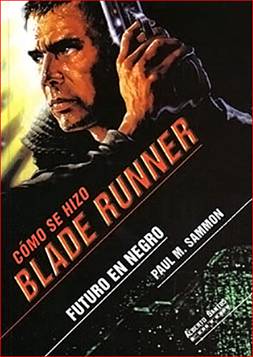
2007
Japanese & 2004 Spanish editions of Future Noir
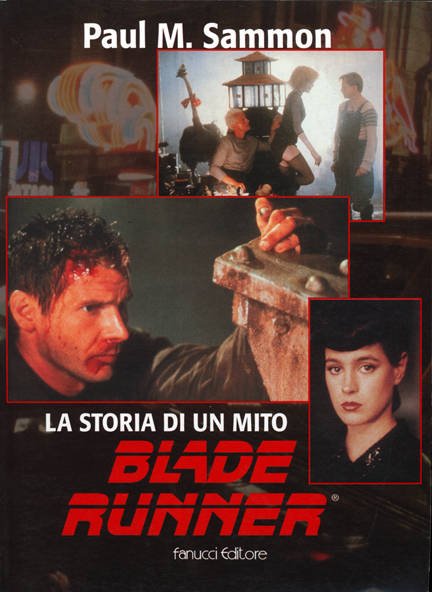
1998 Italian
edition of Future Noir
Will you be available for any signings and appearances to promote
the book? If so, where can we can we plan to see you?
I
should be doing some appearances, perhaps in conjunction with Hollywood
Book & Poster, which I mention in the book. I may be doing a signing
sponsored by them around March 17, 2008, at a fantasy convention. But
I’ll certainly keep BladeZone posted as to that one, or any others.
With
your participation in the documentaries on the Blade Runner: The Final
Cut DVD set, what do you think fans can expect to see in this documentary?
The
best doco on the film ever made. Period. It’s titled Dangerous Days,
and it’s fabulously all-inclusive. Charles de Lauzirika is primarily
responsible for that, and he’s crafted what has to be the best multi-media
examination of the film yet. Just to give you an idea of how thorough
Charlie was, he and his crew videotaped me for about seven or eight hours
for that documentary, during a single session! We literally recorded over
400 minutes of video of me talking. In one sitting, with no breaks! Well,
except for water and the bathroom.
Did
you provide a commentary as well?
I
originally provided commentaries tracks for three versions of the film
- the Director’s Cut, the International Cut, and the Domestic Cut.
Then a technical problem arose with the branching technology on that particular
disc, as I understand it, so I was asked to do a fourth commentary, this
one for the Workprint. That’s the only one that made it onto a DVD
set. My Workprint commentary appears in the 5-disc, “Ultimate Collector’s
Edition” set. It was done in real-time, and in a single take.
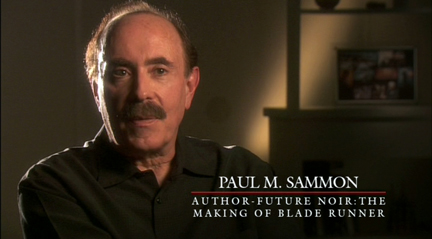
Paul M. Sammon
in a screenshot from the BR documentary DANGEROUS DAYS
What are your thoughts on the look and sound of the new restoration
of the film?
Blade
Runner was always meant to be viewed on the big screen, and it’s
always been best experienced on the big screen. So it gives me tremendous
pleasure to report that The Final Cut is, hands-down, the best-looking,
best-sounding Blade Runner ever shown in a theater. That includes the
original 1982 70mm, six-track theatrical prints, one of which I caught
in Los Angeles back in the day. The Final Cut has been so well restored,
in fact, both visually and aurally, that seeing it in a hardtop again
was like seeing it fresh, for the first time. Of course, since it’s
a digitally created product, the best place to theatrically experience
The Final Cut is in a house equipped with digital projection. Watching
the FC that way is astonishing – there’s an interesting dimensionality
to some scenes that almost make them look 3-D. Plus, I kept spotting little
details in the digitally-projected Final Cut, like scraps of waste paper
on Deckard’s apartment’s floor, that I had never noticed before.
For someone like myself to notice that, who’s
already viewed BR so many, many times – well, that’s really
saying something!
How
was your experience seeing it 25 years later at the Landmark Theatre in
Los Angeles?
Gary Willoughby
and I caught a digitally-projected Final Cut on October 5, the first day
it opened in Los Angeles. And as the lights came down, I recall silently
asking myself, “Am I actually going to be able to sit through this
one more time?” Then came the incredible “BOOM!” that
precedes BR’s opening credits, and I was sucked in all over again.
Interestingly, after that particular screening, I recall being struck
by how crucial Charles Knode and Michael Kaplan’s wardrobes were
to the picture. I mean, Knode’s costume designs for Blade Runner
aren’t only stunning, they’re believable. And during that
screening I was also impressed - once again - by Terry Rawlings’
editing. BR is an incredibly tight film. You could bounce a dime
off of it, you know? The cutting is so smooth, and rhythmic. So very,
very tight. I’ve never understood people who are put off by the
film’s pace.
Do
you have any words you can relay from other members of the crew after
they viewed the film?
Joanna
Cassidy had an interesting reaction. For the Second Edition Future Noir,
I asked people associated with the film to give me some new thoughts about
BR’s 25th anniversary, or about The Final Cut. Joanna responded
by composing a poem, That you will find in the new FN. One of its couplets
summed up Joanna’s feelings: “I dare you all to leave it lay/This
perfect movie of its day.”
What
support did you provide for Warner Home Video’s Blade Runner website?
Well,
as I already mentioned, I wrote up a new three-part history of the film,
broken down into its pre-production, principal photography, and post-production
periods. You can find them by going to www.bladerunnerthemovie.com and
then clicking on “The Film” tab, on the home page’s
menu bar. Anyway, those were done in two different formats, so I guess
you could say that I actually wrote six essays for the Warner Bros. site.
Three were 400 word summaries that you can read on the website, and three
are a trio of different 4000 word essays that you can download as separate
PDFs. Warner Home Video also was kind enough to provide a link for me
on their site that connects to amazon.com, where you can purchase a copy
of Future Noir. By the way, I must say that WHV’s marketing campaign
for The Final Cut and their BR DVD sets was something special. I’m
not just saying this to be polite, either. Warner Bros. really did an
excellent job of getting the word out.
Now,
Warner Bros. also set up the opportunity for me to compose a new 7000
word essay about Philip K. Dick’s reaction to the process of BR’s
creation. That will appear, I think, in December 2007 from Del Rey Books,
in their latest edition of Do Androids Dream of Electric Sheep? I was
very happy to do that essay, because most people don’t realize that
I actually had known Phil Dick for almost a decade before we started talking
about Ridley Scott. I mean, it was a casual relationship, but I first
met Dick in 1973, after a lecture he’d given at Cal State Fullerton
College. Our paths then occasionally crossed throughout the rest of the
1970’s, mostly at parties or science fiction conventions. And from
1980-1982, we spoke and met any number of times. That was a wonderful
period, Phil could be a very warm guy, and we had endless, fascinating
conversations about virtually everything. That was flattering, because
Dick seemed to trust me. Particularly after he realized I was such a long-term
admirer of his work – I read my first Dick story in 1959 - and particularly
after Phil read what I’d written about him in Omni, which was even-handed
and respectful. And we were working on a friendship when he abruptly passed
away. That’s why I was so happy to not only write my PKD essay for
Del Rey, but to be able to include some audio snippets from the actual
telephone interviews I did with Dick about BR on the upcoming BR DVDs.
Those excerpts from my Phil-talks will appear on the four and five-disc
Blade Runner DVD sets.
So
if you take my involvement with the Blade Runner DVD into account, and
then factor in the three BR articles I wrote for Empire magazine, plus
the six essays I did for the BR website, and the long piece I wrote for
Del Rey Books, and the 70, 000 word update I did for Future Noir…well,
2007 was definitely the year of Blade Runner at the Sammon house!
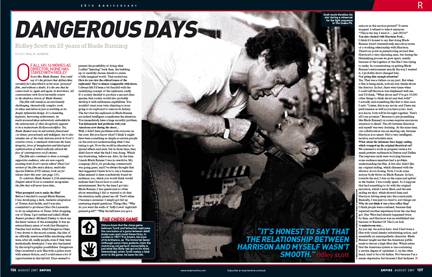
Sammon’s
2007 Empire Magazine Article on Ridley Scott
Philip K. Dick’s stories reached beyond his time, drafting
human situations beyond the ability of science; do you think he would
have continued to do the same if he was writing today?
Of
course. Phil was a writer, which means he could do anything but not write.
So he certainly would have continued practicing his craft, using present-day
circumstances as goads to his critical imaginings. For example, I’m
sure Phil would have found a lot of raw material to play with during the
Reagan Era And since he was also a professional SF scribe, in contact
with other writers of the same ilk, Phil most certainly would have continued
to comment on whatever current technologies interested him, I mean, just
think of what PKD could have done with our own digital age, when so many
events take place in these intangible, virtual worlds. That’s the
sort of thing that was right up his thematic alley.

Sammon
in the BR Art Department, circa 1980
On the other hand, there was clear evidence in his
writing of Phil’s increasing fascination with religion and spirituality
during the final years of his life. So who knows? Perhaps Dick would have
continued to explore humanity’s urge to worship, or ventured further
into man’s relationship with the God principle. All I know is that,
25 years later, I still miss him. Phil was one-of-a-kind.
BladeZone would
like to congratulate you on your achievements, Mr. Sammon. Is there any
other new project you’d like to alert our readers to?
I’ve
just done a coffee-table art book covering 75 years in the history of
a fictional character, Conan the barbarian. Most people know him from
the 1980’s Arnold Schwarzenegger movies, but Conan was actually
created back in 1932, and he’s never been off the pop-culture-map
since. The book is called CONAN THE PHENOMENON. It’s a lovely text-and-art
package. One that I’m actually rather pleased with. It’s published
by Dark Horse Books.

Thank you for taking the time with us – we look forward
to reading your Second Edition of Future Noir: The Making of Blade Runner.
Me
too! (laughs). Thanks for taking the time to interview me, Bryan. One
last thing - here’s a BIG HUG for anyone who’s ever read,
bought or appreciated Future Noir. I truly do appreciate your support.
As they say in the
Phillippines – Salamat po!*
* Thank
you!
THE END

Paul M. Sammon
– Photo by Sherri Sammon |
|

